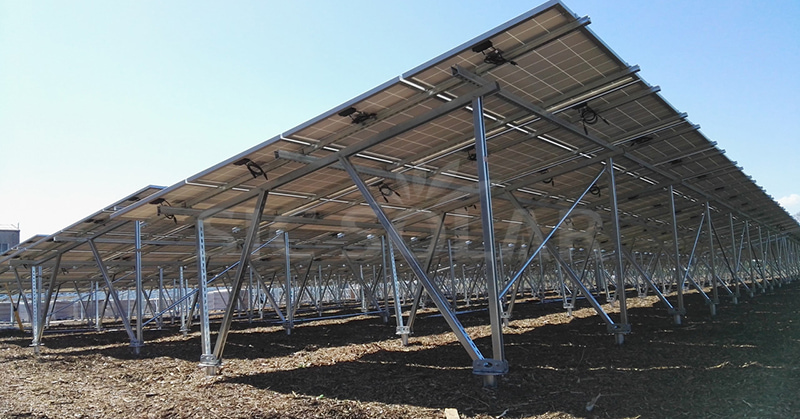Ground screws have become a popular foundation solution in solar installations, offering flexibility, durability and environmental friendliness when compared to traditional concrete foundations. They are used to firmly anchor the solar panel support system to the ground without extensive excavation or pouring of concrete. Different types of ground screws are available to meet the needs of a variety of terrains, soil types and project designs.
SIC Solar is a leading supplier of photovoltaic installation systems and also produces reliable ground screws specifically tailored for solar applications.
What Are Ground Screws?
Ground screws are metal foundation solutions that are screwed directly into the soil to provide a stable and secure foundation for the structure. They are widely used in solar installations as well as fencing, signage and light construction. Ground screws offer a number of advantages such as quick installation, minimal disruption to the site and adaptability to uneven terrain.
Types of Ground Screws for Solar Installations
-
Standard Ground Screws
- Description: These are the most common types of floor screws and are simple in design, with a threaded shaft and pointed tip.
- Application: Suitable for use in soft to medium-density soils for small and medium-sized solar projects.
- Advantages: Easy to install and cost-effective for general applications.
-
Flanged Ground Screws
- Description: The top of the flange foot screw has a flat flange, which can firmly fix the mounting bracket.
- Application: Ideal for projects that require a strong connection, such as heavy-duty solar support systems.
- Advantages: Provides excellent stability and load distribution.
-
Helical Ground Screws
- Description: These screws have spiral blades along their axis to enhance their grip in soft or loose soils.
- Application: Best suited for sandy or unstable surfaces that require additional anchorage strength.
- Advantages: High retention capacity and resistance to displacement.
-
Rock Screws
- Description: These screws are designed for use in rocky or hard soils and feature specialized tips that can penetrate dense surfaces.
- Application: For use in terrain with high rock content, where standard screws are difficult to use.
- Advantages: Can be firmly anchored in challenging geological conditions.
-
Adjustable Ground Screws
- Description: These screws include adjustable heads or extensions for precise leveling during installation.
- Application: Suitable for uneven or sloping terrain that requires height adjustment.
- Advantages: Widely used and can be customized according to various field conditions.
-
Long Shaft Ground Screws
- Description: These screws are longer than standard anchor screws and are used for projects that require deeper anchoring.
- Application: Suitable for areas with loose soil or where additional stability is required.
- Advantages: Enhanced resistance to pulling force.
-
Tapered Ground Screws
- Description: These screws are conical in shape to provide better penetration in hard soils.
- Application: For dense clay or compacted ground conditions.
- Advantages: Easier to install in hard soil types.
Choosing the Right Ground Screw
Selecting the appropriate ground screw depends on several factors:
- Soil Type: Determine the soil composition of the installation site. Loose, sandy, rocky or hard soils require different screw designs.
- Load Requirements: Consider the weight and size of the solar support system or structure being supported.
- Site Conditions: Analyze the terrain for slopes, irregularities, or obstacles that could affect the installation.
- Environmental Impact: Ground screws are environmentally friendly because they do not require a concrete foundation and minimize disruption to the land.
SIC Solar offers a range of ground screws designed to meet a wide range of project requirements. Their products are carefully designed to last and perform well, providing a solid foundation for solar installations of any size.
Benefits of Ground Screws in Solar Projects
-
Quick Installation
The installation speed of floor screws is faster than that of concrete foundations, thus reducing labor costs and project time. -
Minimal Environmental Impact
Ground screws eliminate the need for excavation and concrete, protecting the natural terrain and reducing carbon emissions. -
Reusability
Unlike concrete foundations, floor screws can be disassembled and reused, making them an environmentally friendly option for temporary installations. -
Adaptability
Ground screws can be installed on uneven or sloping terrain without extensive on-site preparation. -
Cost-Effectiveness
Reducing material and labor costs makes floor screws a competitive alternative to traditional foundations.
SIC Solar Expertise in Ground Screws
SIC Solar specializes in the manufacture of high-quality ground screws for use in solar mounting systems. Their products are designed to be used in a variety of soil conditions, providing a reliable and long-lasting solution for solar projects. SIC Solar specializes in precision engineering, ensuring that their ground screws provide the best stability and ease of installation, making them the first choice for solar professionals worldwide.


















